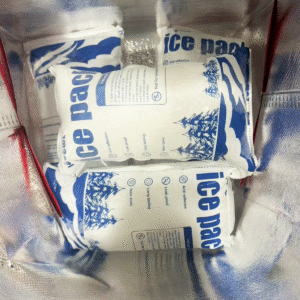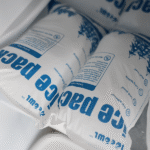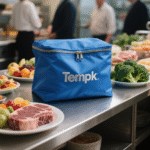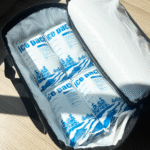How to Pack Ice Cream with Dry Ice in 2025
You want rock‑solid pints at the door, not slush. Here’s how to pack ice cream with dry ice the right way—step‑by‑step methods, exact ice math, and compliant labels—so your shipment holds 0°F (‑18°C) for 24–72 hours without waste. Most small coolers need 5–10 lb of dry ice per 24 Std.; thicker insulation and hot routes need more.
-
How to layer pints and dry ice for even cold on 24–72‑hour routes
-
How much dry ice to use with a simple, testable calculator
-
Which insulated shipper (EPS, Pur, VIP) fits time and budget
-
How to label and vent packages for USPS/UPS/FedEx compliance
-
When gel packs help—and when dry ice must lead
How do you pack ice cream with dry ice step by step?
Quick answer: Pre‑freeze pints, pre‑condition the shipper, line with a poly bag, add a base layer of dry ice, pack pints tightly, top‑load more dry ice, fill all voids, keep vents open, and label correctly. Do not seal airtight; CO₂ must escape. Planen 5–10 lb dry ice per 24 Std. for small coolers; increase for thin walls or heat waves.
Warum funktioniert es: Dry ice is ‑109°F (‑78.5°C). Cold gas sinks. Putting most ice above the pints feeds cold downward and slows heat gain. A “sandwich” (base ice → pints → top ice) evens temperatures and prevents lid warp. Venting avoids pressure build‑up and keeps handlers safe.
Which insulated shipper should you choose for how to pack ice cream with dry ice?
Pick wall thickness by transit time. Verwenden ~1.5″ EPS for 24–48 h. Step up to 1.75–2.25″ EPS oder PUR/VIP für 48+ h or hot lanes. PUR insulates better than EPS; VIP gives the longest hold in the smallest footprint.
| Pack‑out choice | Typical spec | Am besten für | Was es für Sie bedeutet |
|---|---|---|---|
| 1.5″ EPS | Budget foam | 24–36 h | Good for overnight; add buffer ice |
| 1.75–2.25″ EPS | Thick foam | 36–48 h | Two‑day lanes; moderate heat |
| PUR or VIP | Higher R‑value | 48–72 h+ | Smaller box, less ice, premium price |
Praktische Tipps, die Sie heute verwenden können
-
Pre‑condition the shipper in a freezer for 1–2 hours.
-
Mix blocks + pellets: blocks last, pellets fill gaps.
-
Eliminate headspace: paper void fill beats warm air.
Real case: A creamery shipped 12 pints in summer using a 1.75″ EPS shipper and 18 lb of mixed dry ice with a top‑heavy layout. Delivery at 46 Std.: pints arrived rock‑solid; lids intact.
How much dry ice do you need when you pack ice cream with dry ice?
Faustregel: Start at 5–10 lb per 24 H for well‑insulated small coolers. Scale for thicker walls, payload size, and weather. For 36–48 h, 12 pints often need 15–22 lb in 1.75–2.25″ EPS. Always validate with a lane test.
Make it predictable: Sublimation depends on insulation, mass, and airflow. Use a simple estimator, then add a heat‑season buffer (+20% in hot months). Keep most ice above the pints. For long lanes or heat waves, upgrade to PUR/VIP to cut required ice mass and risk.
Dry ice estimator (copy/paste to Sheets)
-
Rate_lb_per_day: fangen Sie an 7.5 (midpoint of 5–10).
-
Route_Factor: 1.0 Cool / 1.2 shoulder / 1.4 heiß.
-
Box_Factor: 0.9 PUR/VIP; 1.0 for 1.75–2.25″ EPS; 1.2 for 1.0–1.5″ EPS.
Beispiel: 36 H, hot route (1.4), 1.5″ EPS (1.2) → =ROUNDUP((36/24)*7.5*1.4*1.2,0) → 19 lb Trockeneis.
| Nutzlast (pints) | Box type | Window | Est. Trockeneis | Your takeaway |
|---|---|---|---|---|
| 6–8 | 1.5″ EPS | 24–36 h | 8–12 lb | Overnight plus buffer |
| 12 | 1.75–2.25″ EPS | 36–48 h | 15–22 lb | Two‑day lanes in warm weather |
| 18–24 | 2.25″ EPS / Pur | 48–60 h | 25–35 lb | Long zone‑skips; Wochenende hält |
Layout that keeps pints hard‑frozen
-
Base layer: 0.5–1″ pellets wrapped in paper.
-
Payload zone: tight rows; no gaps.
-
Side cavities: 0.5–1″ pellet bags on “hot” walls.
-
Top layer: 1–2″ blocks + pellets.
This “cold well” evens temperatures and extends hold time.
How do you stay compliant when you pack ice cream with dry ice?
Do this every time: Markieren “Dry ice” or “Carbon dioxide, solide,” UN1845, list net dry‑ice weight, use the Klasse 9 Etikett (Luft), Und Entlüftung the package—no airtight internals. USPS allows dry ice domestically with air limits; international via USPS is prohibited. UPS/FedEx follow IATA PI 954 für Luft.
Warum ist es wichtig: CO₂ gas must escape to prevent pressure build‑up and oxygen displacement. Proper labels keep your parcel moving and protect handlers. USPS air has a 5 lb limit per mailpiece; ground can exceed but must stay surface. International shipments require private carriers and IATA‑compliant marking.
Labeling checklist for how to pack ice cream with dry ice
-
Richtiger Versandname: Trockeneis / Kohlendioxid, solide
-
UN1845 clearly marked
-
Net weight of dry ice (kg or lb) on the outside
-
Klasse 9 Hazard -Etikett (100 mm) for air shipments
-
Vented packaging; do not seal liner airtight
| Carrier / Modus | Key limit | Must‑have marks | Notes |
|---|---|---|---|
| USPS (Luft) | ≤5 lb dry ice | UN1845 + Klasse 9 + Nettogewicht | Domestic only; international prohibited |
| USPS (Boden) | No fixed limit | „Kohlendioxid, solide" + Nettogewicht | Surface transport only |
| UPS/FEDEX (Luft) | Hier ist pi 954 | UN1845 + Klasse 9 + Nettogewicht | Station acceptance rules vary |
Is dry ice always best, or when do gel packs help?
Dry ice is the nur way to hold a true freeze for ice cream. Gel packs are for chilled ranges. A hybrid (top dry ice + side gel) can buffer delicate pints or mixed loads and reduce lid warp on long lanes. For 0°F targets, keep dry ice primary.
2025 trends shaping how to pack ice cream with dry ice
Trend snapshot: Brands are shifting from standard EPS to PUR/VIP to shrink box size and dry‑ice mass while extending hold time. Low‑cost data loggers make lane qualification simple. Shippers are “right‑sizing” dry ice with validated calculators instead of rules of thumb, cutting waste and cost.
Neueste Fortschritte auf einen Blick
-
VIP goes mainstream: Longer hold in smaller cartons; fewer re‑packs.
-
Smarter monitoring: API‑enabled loggers prove compliance and reduce claims.
-
Greener CO₂ usage: Better modeling prevents over‑icing without risking thaw.
Market insight: Cold‑chain packaging demand keeps climbing with DTC desserts and e‑grocery. Thicker EPS tiers and VIP adoption support 48–72‑hour windows without premium services—key for margin.
FAQs
How long will dry ice keep ice cream frozen?
Um 24–72 Stunden depending on insulation and ice mass. Start at 5–10 lb per 24 h and validate on your lane.
Wie viel Trockeneis für 12 pints, 36–48 h?
Planen 15–22 lb in 1.75–2.25″ EPS with a top‑heavy layout; hinzufügen 20% in heat waves.
Can I ship internationally with USPS?
NEIN. USPS prohibits dry ice in international mail. Use private carriers with IATA‑compliant labels.
Where should the dry ice sit?
Mostly above the pints; add side pellet bags on hot walls to even temperatures.
Is venting mandatory?
Ja. Inner liner and outer carton must allow CO₂ to escape; never seal airtight.
Zusammenfassung & Empfehlungen
Schlüsselpunkte: You’ve learned how to pack ice cream with dry ice using a layered layout, right‑sized ice (5–10 lb/24 h as a baseline), thicker insulation for longer routes, and compliant marking (UN1845, Klasse 9 für Luft). Validate with one test ship per lane and a logger before scaling.
Nächste Schritte (action plan):
-
Qualify your lane: Run one test with a temp logger.
-
Pick packaging: 1.75–2.25″ EPS for 36–48 h; PUR/VIP for 48–72 h.
-
Calculate ice: Use the estimator, then add seasonal buffer.
-
Etikett & Entlüftung: UN1845, Nettogewicht, Klasse 9 (Luft), no airtight seals.
Über Tempk
We engineer lane‑validated frozen pack‑outs—insulated shippers, right‑sized dry‑ice charts, and simple SOPs—so your pints arrive hard‑frozen without overspending on ice or service upgrades. Our kits include compliant labels and logger workflows, backed by technicians who’ve shipped millions of units. Let’s tailor a pack‑out that fits your routes and budget.
CTA: Ready to de‑risk your frozen launches? Contact Tempk for a 15‑minute packaging review.
























